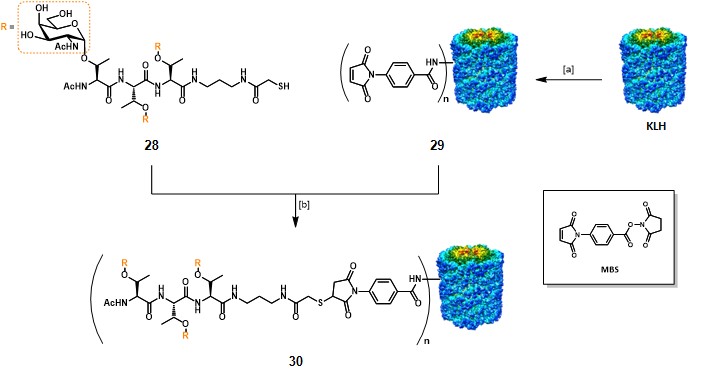In the frame of clustered monomeric vaccines, Danishefsky’s research group reported the synthesis and immunological evaluations of a clustered Tn-based conjugate vaccine (30), where a cluster of three threonine-linked Tn antigens (28) was conjugated to the KLH carrier protein (Scheme 4).Kagan et al., 2005

The clustered B-cell epitope 28, containing a terminal sulfhydryl group was obtained by chemical synthesis. KLH protein was treated with m-maleimidobenzoyl-N-hydroxysuccinimide ester (MBS) to obtain maleimidated KLH 29, which subsequently underwent thiol-maleimide coupling to give vaccine 30. The epitope ratio (n) was determined by high-pH anion-exchange chromatography with pulsed amperometric detection (HPAEC-PAD) assay for carbohydrate after acid hydrolysis ; two batches of 30 were obtained, with an epitope ratio of 201:1 and 648:1, respectively. The clustered vaccine 30 was tested in comparison with its monomeric version ; C57BL/6 female mice were immunized three times with 3 µg of Tn-based vaccine plus 10 µg of QS-21. Previous reports by Kurosaka et al. (A monoclonal antibody that recognizes a cluster of a disaccharide, NeuAcα2→6GalNAc, in mucin-type glycoproteins) and Nakada et al. (Epitopic structure of Tn glycophorin A for an anti-Tn antibody) suggested that a clustered display of STn and Tn antigens allows an improved recognition by mAbs MLS 102 and MLS 128, respectively.Kurosaka et al., 1988Nakada et al., 1993 Danishefsky and co-workers demonstrated that clustered Tn-KLH conjugate 30 (Scheme 4) is consistently a better form of Tn for inducing high titers of antigen-specific IgG and IgM, which are able to bind two sources of naturally expressed Tn (i.e. dOSM : desialylated ovine submaxillary mucin, and LSC : a human colon cancer cell line that express Tn but not MUC1).
Following the same design approach, the Danishefsky group carried out a clinical trial on 20 patients with biochemically relapsed prostate cancer by administering clustered TF-KLH conjugate vaccine 31(Figure 4).Slovin et al., 2005

Two batches of 31 were obtained : with an estimated epitope ratio (n) of 466:1 (batch A) and 579:1 (batch B). Four cohorts, each composed of five patients, were vaccinated with different doses of 31 along with 100 µg of QS-21 : 1 µg (batch B), 3 µg, 10 µg and 30 µg (batch A). The toxicity of this vaccine formulation was comparable to that observed in previous trials, where other TACA-KLH conjugates plus QS-21 were administered. All patients developed TF-specific IgM and IgG (mainly IgG1 and IgG3, determined by ELISA). Overall, the IgM and IgG titers at the 1 µg and 3 µg doses were at least as high as at the higher doses. Once again, clustering appears to be a valid way to mimic the way “simple” antigens, expressed on epithelial but not normal tissues.Scher et al., 2004
